What Is The White Stuff In My Turtle Tank?
If you’ve ever looked closely at your turtle’s tank, you may have noticed a white, powdery substance on the glass. And you may be wondering, what is that white stuff in my turtle tank?
Most likely, the white stuff in your turtle tank is calcium deposits from the water. Over time, these can build up and create a hard, white coating on the inside of your tank. It’s a natural byproduct of the water in your turtle’s tank.
Calcium carbonate is created when water molecules combine with carbon dioxide molecules in the air. This process is called chemical precipitation, and it’s how most of the world’s limestone is formed.
While it’s not harmful to your turtle, it can be unsightly. To remove it, simply scrub it away with a soft brush. However, if you’re having trouble getting rid of the calcium deposits, you may need to use a stronger cleaning solution or even sandpaper to remove them.
There are a few other things it could be (white stuff). Let us discuss all the possibilities and how to solve the issue without hurting your tank’s environment.
Related Blog:
All The Possible Reasons For The White Stuff In Your Turtle Tank
A number of reasons can couse the appearance of the white stuff in the aquarium. And every reason needs different treatment. Those are:
Biofilm:
Your calcium carbonate may have formed higher and become biofilm, and it’s actually a good thing! Biofilm is created when bacteria and other microorganisms attach to surfaces and begin to multiply. This process is known as colonization.
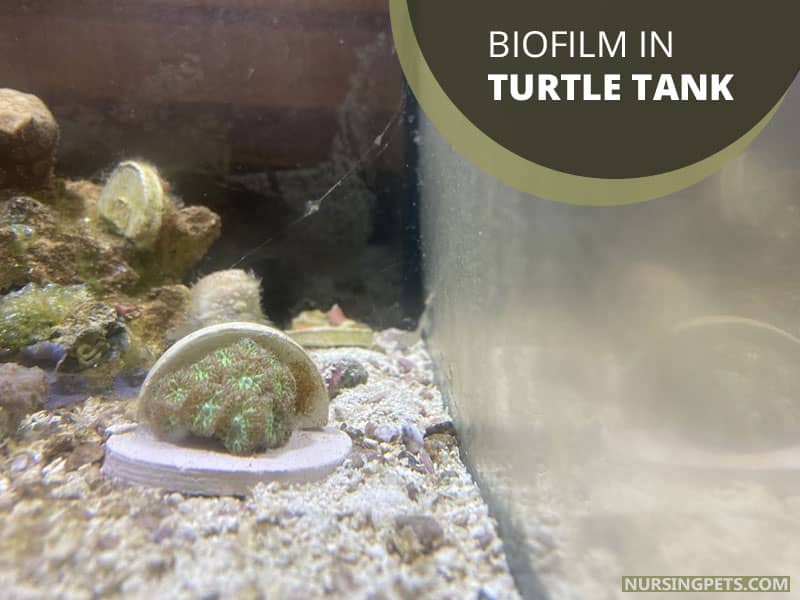
Biofilm provides a protective barrier for the bacteria and also contains nutrients that the bacteria can feed on. This can be beneficial for your turtle, as it can provide a source of food and shelter.
However, biofilm can also harbor harmful bacteria, so it’s important to keep an eye on it and remove any build-up that looks unhealthy.
But if you’re concerned about the biofilm in your turtle tank, the best thing to do is to talk to your vet. They will be able to advise you on the best way to keep your turtle healthy and happy.
Fungus:
In case your white stuff looks like little pieces of cotton floating around, this is actually turtle fungus, and while it may not look very pretty, it’s a common occurrence in turtle tanks.
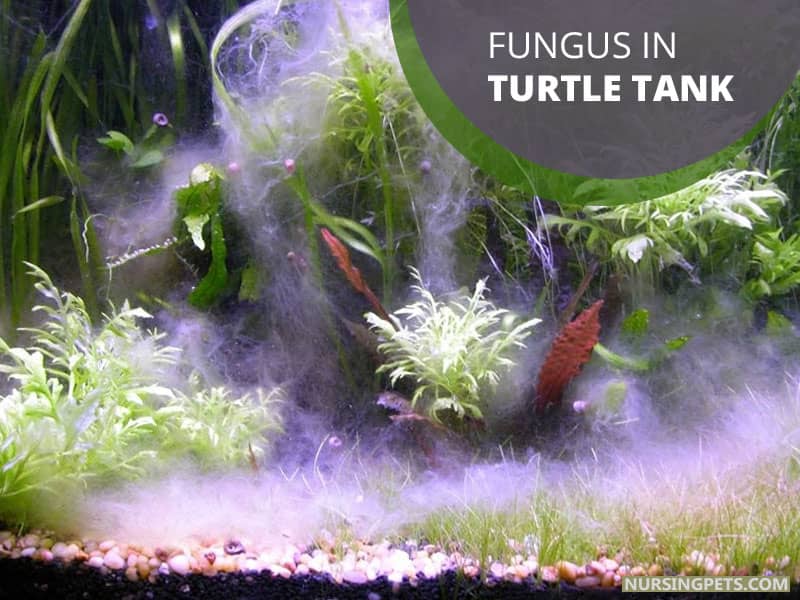
Turtle fungus is caused by a type of bacteria that is commonly found in water. These bacteria can cause an infection in your turtle’s shell, which can lead to the growth of fungus. While turtle fungus is not harmful to your turtle, it can be displeasing and may cause your turtle to feel uncomfortable.
Suppose you notice turtle fungus in your tank. The best thing to do is to clean the tank and remove any infected areas of the shell. You can also treat the infection with antibiotics, but be sure to talk to your veterinarian first.
Vibrio:
Vibrio is a common type of bacteria found in fresh and salt water. It’s also common in soil and on plant surfaces. While vibrio itself isn’t harmful to turtles, it can cause problems if it gets into their tank and starts to multiply.
It releases a waste product that can make the water appear cloudy. However, this isn’t harmful to turtles, but it can be a nuisance.
Mold:
The white, powdery substance on the walls or floor of your turtle tank could be mold. This isn’t harmful to turtles, but not a pleasant view either and can cause respiratory problems in humans.
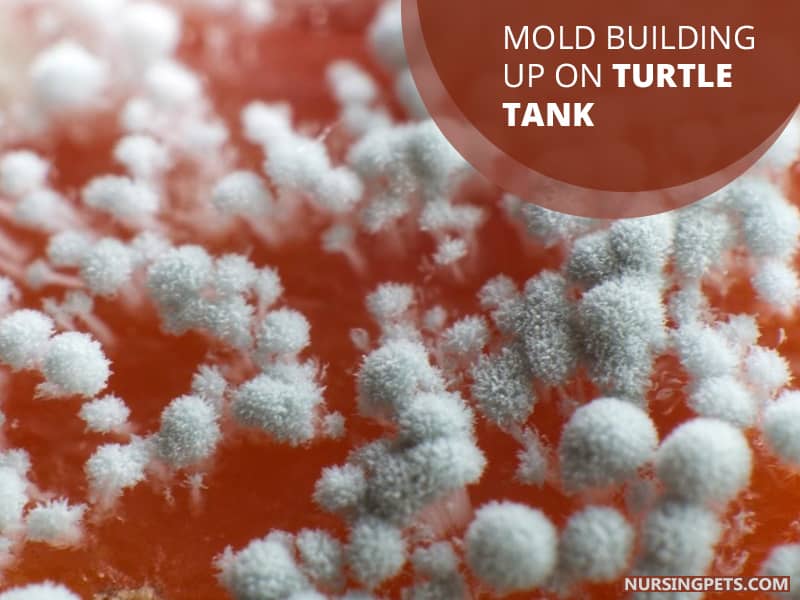
If you have mold in your turtle tank, you’ll need to take action to remove it.
You can do a few things to get rid of mold in your turtle tank. First, increase the temperature of the water. Mold thrives in cool, damp environments, so raising the water temperature will make it less hospitable for mold.
You can also add a UVB light to the tank, which will help to prevent mold growth. Finally, clean the tank regularly and remove any food or waste that mold can feed on.
Remains of the Eggshell:
It could be the remains of the eggshells from when the turtles were born, or it could be waste material from the turtles themselves. If it’s the latter, you’ll need to clean out the tank more frequently to prevent waste.
Pond Scum:
When you notice white stuff floating in your turtle tank, this substance is called turtle pond scum, and it’s made up of beneficial bacteria that help keep your turtle’s environment clean.

Although pond scum may not look very appealing, it’s actually an important part of healthy turtle habitat. This bacteria helps to break down waste products and keep your water quality high.
When pond scum is starting to build up too much, you can simply remove it with a net. However, be sure not to remove all of the scum, as this can upset the delicate balance of your turtle’s ecosystem.
Turtle Waste:
The white stuff floating stuff in your turtle tank also could be turtle waste. While it’s perfectly normal for there to be some waste in your turtle tank, too much can lead to health problems for your turtle.
Turtle waste is made up of both solid and liquid waste products. The solid waste is made up of things like turtle shell fragments, uneaten food, and dead plants. And the liquid waste is made up of things like urine and turtle excrement.
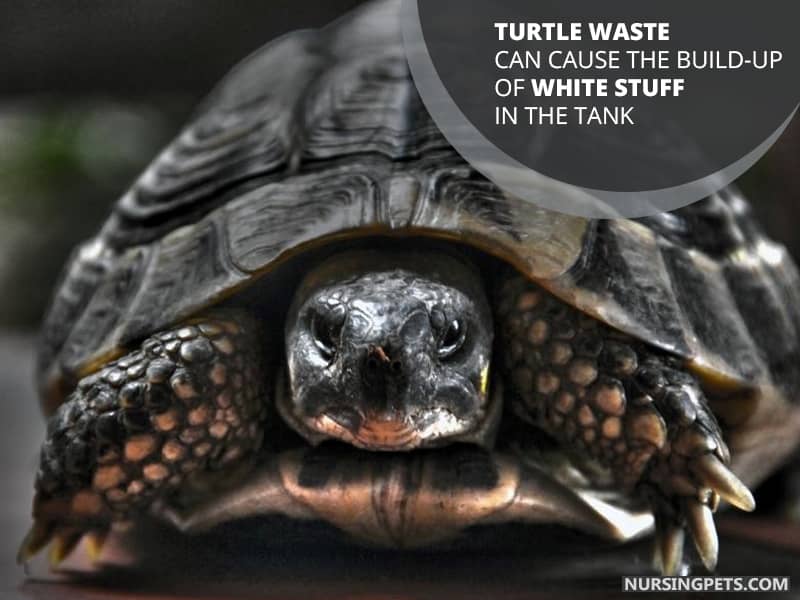
When these waste products mix together, they form the white stuff that you see in your turtle tank.
And too much waste in the tank can lead to a build-up of harmful bacteria that can make your turtle sick. Additionally, a high level of waste in the tank can cause the water to become polluted, which can also make your turtle sick.
To clean up the waste in your turtle tank, you’ll need to do a partial water change. This means that you’ll need to remove some of the water from the tank and replace it with clean water.
You’ll have to remove any solid waste from the tank with a net or a turtle waste removal tool. Once you’ve removed the solid ones, you can vacuum the gravel to remove any liquid waste. Finally, you should clean all the turtle tank surfaces with a turtle-safe cleaner.
By following these steps, you can control the level of waste in your turtle tank and help keep your turtle healthy.
White Algae:
The white stuff in your turtle tank could be algae. It is a type of plant that can grow in water and on turtle shells. And this is a common problem in turtle tanks because turtles are messy eaters and often leave food behind that algae can feed on. While algae are not harmful to turtles, they can be unsightly.
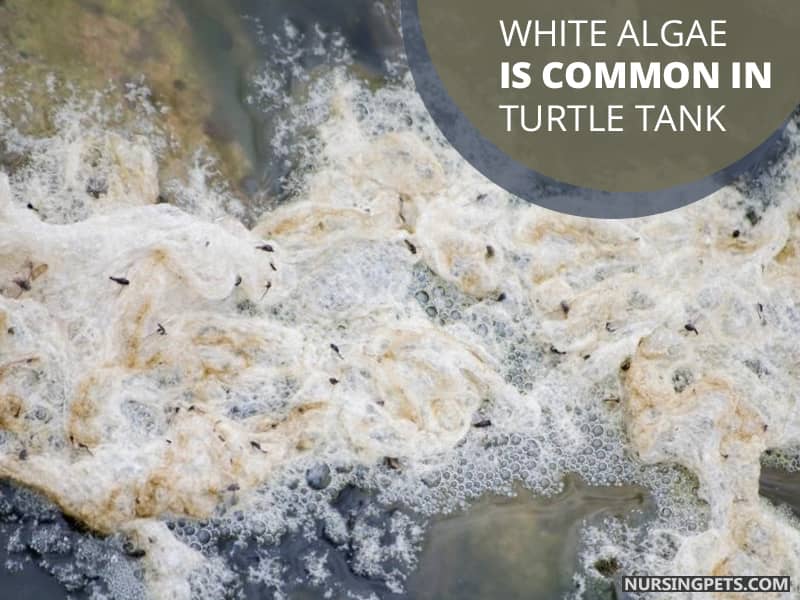
To remove algae from your turtle tank, scrub the affected areas with a soft brush and manually remove them. You can also use a Turtle Tank Algae Cleaner to clean algae from your turtle tank.
However, you will need to do this regularly to keep the algae from coming back.
Also, you can try adding some live plants to your turtle tank. Live plants will compete with algae for food and also help to oxygenate the water.
Moreover, another way to remove algae is to change the water in your turtle tank. You should do a partial water change every week to remove algae and other debris from the water.
When you do a water change, clean the tank with a sponge or brush to remove any algae clinging to the walls.
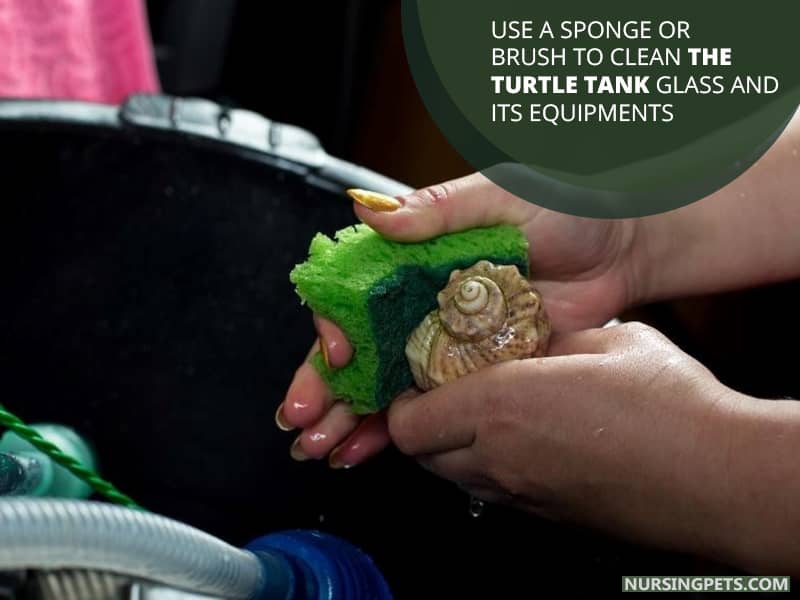
You can also prevent algae from growing in your turtle tank by keeping the tank clean and free of debris. Be sure to remove uneaten food and waste from the tank daily. You should also vacuum the gravel to remove any debris that has sunk to the bottom of the tank.
And by keeping the tank clean, you will create an environment that is less hospitable for algae to grow.
Lastly, you can try using an algae eater in your turtle tank. Algae eaters are fish that eat algae and can help keep your turtle tank clean.
What Causes (Why There Is) White Stuff in Turtle Tanks (All The Possible Reasons)
Multiple things can cause the white stuff in your turtle tank. But the most common ones are:
1. Overcrowding: Too many turtles in one tank can lead to poor water quality and an increase in harmful bacteria. This can cause a white, fuzzy growth on the shells or tank wall.
2. Poor water quality: Turtles are very sensitive to water quality. Ammonia, calcium, and nitrites can build up in the water, causing irritation and infection. This can lead to the white stuff appearances.
3. Diet: A diet that is high in protein can cause a white, fuzzy growth on the shells. Or excess food waste in the turtle tank can help build up mold and fungus.
4. Shell rot: Shell rot is a serious infection that can cause the shell to deteriorate. This can lead to the release of white substances from that
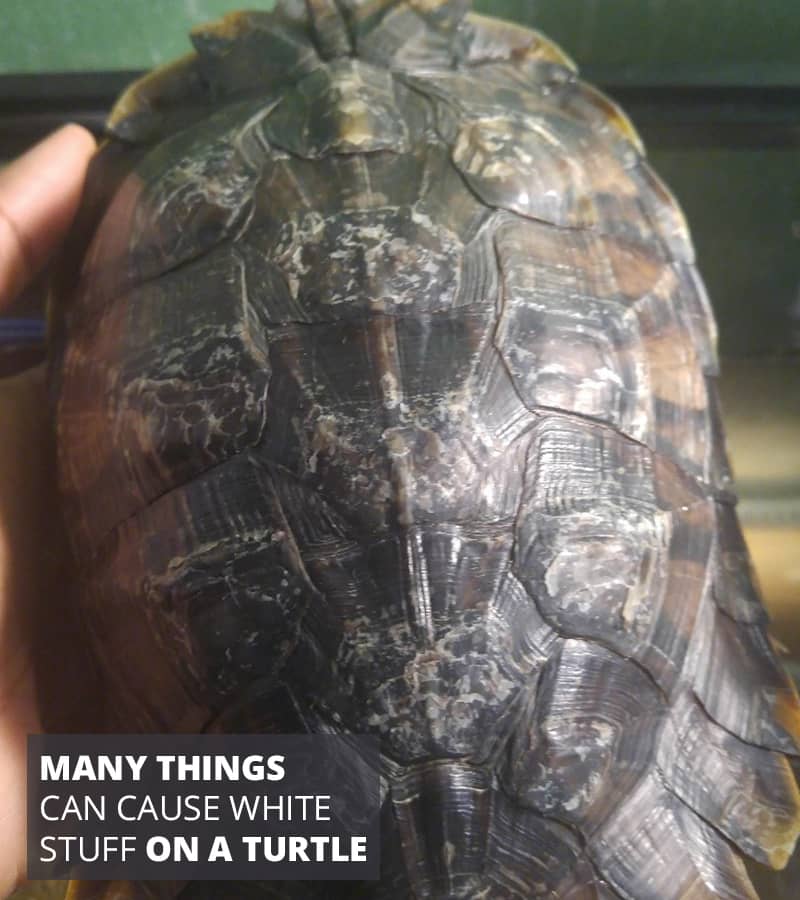
5. Stress: Stress can weaken the immune system, making your turtle more susceptible to infection. This can lead to white stuff advent in the tank.
6. Bacterial Bloom: Finally, the white stuff could also be a bacterial bloom. This happens when there is an excess of nutrients in the water, which can cause bacteria to multiply quickly.
How to Remove/Clean or Get Rid of White Stuff/Residue on Aquarium Glass
If you’ve ever noticed a white, cloudy film on the glass of your aquarium, this common issue is caused by a build-up of minerals, specifically calcium, on the glass. While this white residue is harmless to your turtle, it can be unsightly and difficult to remove.
There are a few different ways to remove white residue from aquarium glass. One popular method is to use a vinegar solution. To make right mix, use same amount of water and vinegar. Then, put the solution into a spary bottle and apply it on the affected areas of the tank.
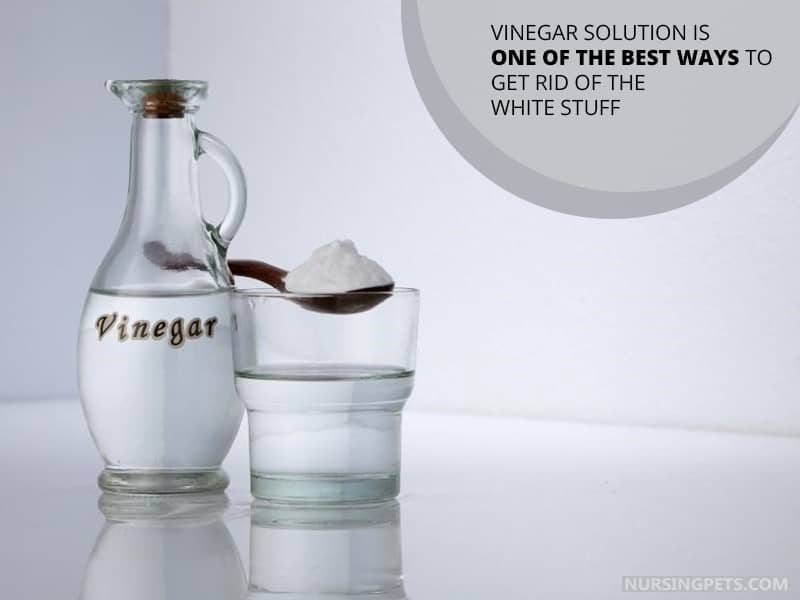
Let the vinegar solution sit for a few minutes before wiping it away with a clean cloth. You may need to use a little elbow grease to get the residue off, but it should come off relatively easily.
If you don’t have vinegar on hand, you can also use a lemon juice solution. Mix equal parts lemon juice and water in a spray bottle and spritz the solution onto the affected areas. Let the lemon juice solution sit for a few minutes before wiping it away with a clean cloth.
However, in case the white residue is particularly stubborn, you may need to use a scraper to remove it. Be sure to use a scraper that is safe for aquarium glass, such as a plastic putty knife. Gently scrape away the residue, being careful not to scratch the glass.
Once you’ve removed the white residue from the glass, you can help prevent it from coming back by regularly cleaning the glass with an aquarium-safe glass cleaner.
Ways To Prevent The White Stuff In My Turtle Tank?
You can do a few things to prevent the white stuff from accumulating in your turtle tank. First, make sure you’re using a good filter. A good filter will help remove some particles that can contribute to the formation of the white stuff.
Second, be sure to clean your turtle tank regularly. A debris build-up can contribute to the formation of the white stuff, so it’s important to keep your turtle tank clean.
Finally, consider using a product like Turtle Clean to help prevent the formation of the white stuff. Turtle Clean is a natural product that helps to break down the particles that can contribute to the form of the white stuff. Click here to check the product on amazon.

You can also help prevent calcium build-up by using a water conditioner that removes hardness from the water.
However, your treatment should be different if your turtle tank has a white algae problem. While a little bit of algae is natural and not harmful to your turtle, too much of it can make the tank look dirty and can be detrimental to your turtle’s health.
Here are some easy ways to prevent algae growth in your turtle tank:
1. Keep your turtle tank clean – This may seem like a no-brainer, but cleaning your turtle tank regularly is essential to prevent algae growth. Remove any debris, uneaten food, or waste from the tank weekly.
2. Don’t overfeed your turtle – Overfeeding your turtle can cause algae growth and other health problems. Feed your turtle only as much food as he or she can eat in one sitting.
3. Use a turtle-safe aquarium cleaner – Many products on the market are safe to use in turtle tanks and will help prevent algae growth.
4. Increase the tank’s water circulation – Algae thrives in stagnant water, so increasing the water circulation in your turtle tank will help prevent its growth. You can do this by adding an aquarium filter or air stone.
5. Reduce the amount of light in the tank – Algae also thrives in light, so reducing the amount of light in your turtle tank will help prevent its growth. If possible, keep the tank out of direct sunlight.
6. Add live plants to the tank – Live plants not only look great in a turtle tank, but they also help to consume the nutrients that algae need to grow.
Following these simple tips can help prevent algae growth in your turtle tank and keep it looking clean and healthy!
Why Is My Turtle Throwing up White Stuff?
If your turtle is throwing up the white stuff, it could be a sign of a couple of different things. It could be a sign of a respiratory infection or something called “shell rot.”
Bacteria, viruses, and fungi usually cause respiratory infections in turtles. And they can be serious if not treated promptly. In case you think your turtle might have a respiratory infection, take it to the vet right away.
Shell rot is a condition that can be caused by a number of things, including poor hygiene, a lack of vitamin A, or exposure to toxins. Shell rot can cause your turtle’s shell to become soft and discolored; it can be fatal if it’s not treated. In case you think your turtle might have shell rot, take it to the vet right away.
What To Do If The White Stuff in My Turtle Tank Gets Out Of Control?
When the white stuff in your turtle tank is getting out of control, there are a few things you can do to fix the problem.
First, you need to figure out what is causing the problem. For example, if you’re overfeeding your turtles, then the excess food will cause the white stuff to grow. Or any other reasons that we have mentioned above like algae, mold, shell rot, fungus, biofilm, etc.
Once you know what you’re dealing with, take steps to remove the white stuff from the tank. This may involve changing the water, cleaning the tank, and/or using chemical treatments. Suppose your turtles are sick; you need to take them to the vet and treat them.
Or, you can try the recommended solutions that we have discussed. That can also help you to control the white stuff in your turtle tank.
However, in some cases, the white stuff in your turtle tank can be helpful. If you have live plants in your tank, the white stuff can help the plants to grow.
Concluding Remark:
There are several things that can be the white stuff in your turtle tank, including fungus, mold, algae, mineral deposits, calcium build-up, shell rot, or turtle waster. However, the most common one is calcium carbonate and mineral deposits.
Whatever the reason, first identify the cause. Then you need to clean it up thoroughly. And after that, take some actions to prevent them from returning to your turtle tank in the future.
Image Source:
- Reddit.com
- Fishlab.com
- Thepondguy.com
- Canva.com/photos
- Reef2reef.com

